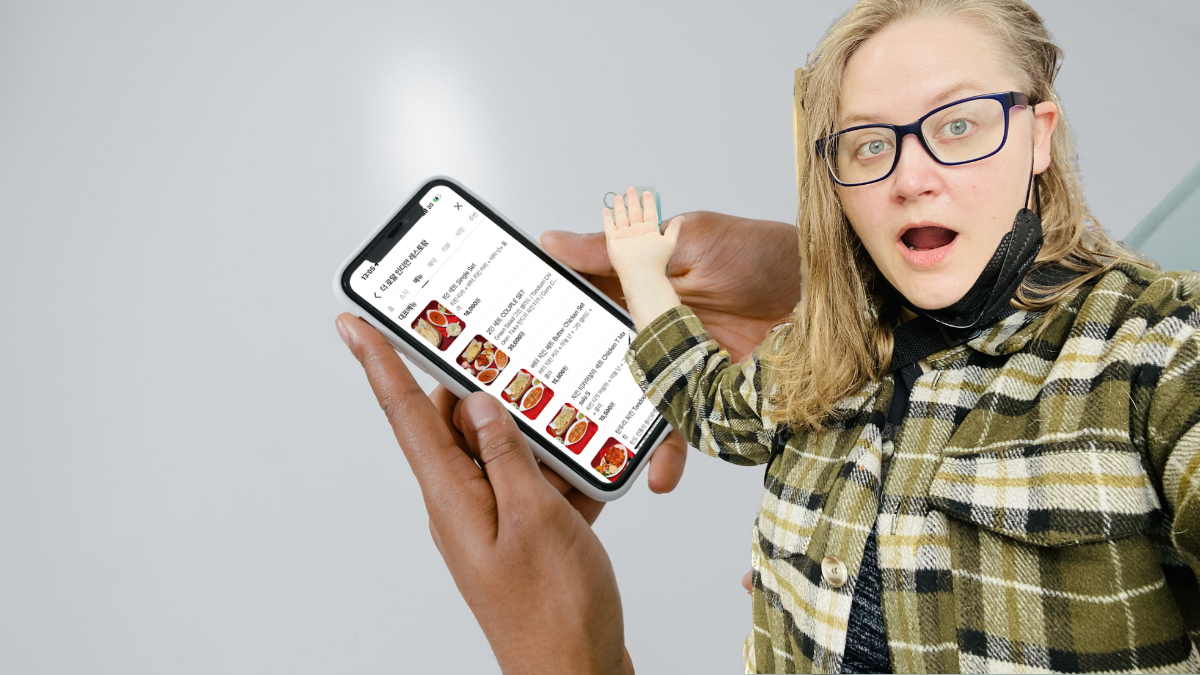
Best Apps for Living in South Korea
Looking for the best apps for living in South Korea? Keep reading!
The Best Apps for Living in South Korea: What to Download and Why
Moving to or living in South Korea means adjusting to a whole new digital environment. While apps like Google Maps and WhatsApp might be your go-to at home, they often don’t work well (or at all) here. Korea has its own set of powerful, localized apps that people rely on for everything from chatting to navigating, shopping, ordering food, and even hailing a taxi.
To really settle into life in Korea, you’ll want to get comfortable with the local app ecosystem. It’ll make everything easier and help you feel more connected to daily life.
Why International Apps Don’t Work So Well in Korea
It’s not that international apps are bad; they simply don’t fit neatly into the way things are done in Korea. There are a few reasons for this:
- Some global apps are restricted due to Korean laws. For example, Google Maps can’t offer full turn-by-turn directions because of how Korea handles map data.
- Language can be a big barrier. Many apps don’t offer Korean, and many Korean apps don’t offer English. That mismatch leaves you stuck in the middle.
- Korea already has its own incredibly efficient apps. Instead of adapting international tools, most people just use what already works well for them (like KakaoTalk instead of WhatsApp).
If you’re relying solely on the apps you used back home, you might feel like you’re constantly running into walls. Switching to local apps opens up a lot more access.
Getting Used to Korean Apps Takes Time
Let’s be honest: Korean apps might feel confusing at first. They often use different symbols, layout styles, and logic than what you’re used to. Things that seem obvious in Western apps—like where to find settings or how to start a chat—might be hidden or labeled differently here.
At first, it might feel frustrating. That’s a normal part of the adjustment. But you don’t have to figure it all out on your own.
Here’s what can help:
- Use Papago, Korea’s popular translation app, to translate screenshots or menus when you’re stuck.
- Ask a friend, coworker, or even a neighbor to walk you through how they use the app.
- Look up a short YouTube video in Korean and turn on auto-translated subtitles. Watching someone else use the app can make things click.
Don’t Wait Until You’re in a Pinch
One of the best things you can do is explore apps before you urgently need them. If you wait until you’re lost or trying to order dinner after a long day, you’ll probably end up overwhelmed.
Try this instead:
- Pick one app at a time and spend 30 minutes or so just clicking around.
- Test out the different buttons and menus while you’re relaxing at home or sitting in a cafe.
- Make notes for yourself about where important features are or how to use them.
A little bit of exploration in a low-pressure moment goes a long way.
What Works for Someone Else Might Not Work for You
There’s no one-size-fits-all list of perfect Korean apps. What’s right for you depends on your habits, your language comfort, and your lifestyle.
Some people love Naver Maps because it links well with blogs and local reviews. Others prefer KakaoMap because the interface feels cleaner. Some stick to Baemin for food delivery, while others swear by Shuttle because it offers more English.
Don’t worry about picking the “right” one on your first try. Try a few and go with what feels most comfortable and useful for your daily life.
Why We Recommend the Apps We Do
At South of Seoul, we only recommend apps that we’ve personally used or that have been tested by members of our volunteer team. We’re not promoting anything because it’s trendy or ad-driven. We’re focused on what actually works—especially for foreigners who plan to live in Korea for more than a few months.
The truth is, many international apps seem to work here at first glance, but once you dig in, you’ll find they don’t offer the depth, accuracy, or access that Korean apps do. We want to make sure people know there are better, more locally integrated options out there—and help them get started.
Recommended Air Quality App
Residents in Korea should have an app that keeps them notified about changing air quality conditions. The following app does just that, making it easy to understand. We also use AirVisual data in our location-specific South of Seoul blog articles.

AirVisual
Description:
What the app does: An app for tracking air quality. Air quality changes throughout the day. Reason to have this app: Since air quality changes throughout the day we recommend keeping an app on your phone that alerts you to changes in air quality in the area around you. Why this air quality app?: There are many air quality apps. Many expats like this one for Korea because of its coverage across rural areas.
Recommended Korean Language Hotel and Travel Apps
Korean travel apps offer a significantly larger catalog of properties, more competitive prices, and better discounts. They also have unique categories like pool villas and dog pensions.
Pro-tip: As of 2022, apps developed in Korea for Korean travel require a Korean bank account and ID to make reservations. However, it’s worth figuring out because if you find a deal on a Korean app, you can have a bilingual concierge service make the reservation for you, and it will still be cheaper and better than using foreign booking websites.

Yogiyeoddae
Hangul Name:
여기어때
Description:
Yogiyeoddae (요기여때) is a hotel booking app designed for residents in Korea, offering same-day and last-minute deals with real-time availability. It provides access to motels, pensions, and boutique hotels often not listed on international platforms like Booking.com. Users benefit from exclusive local discounts, coupons, and fast check-in options. The app is fully in Korean and requires a Korean phone number and local payment method. Although there's a learning curve, residents who adapt gain access to better prices, more lodging options, and a wider range of accommodations tailored to domestic travel needs. Yogiyeoddae is the go-to app for flexible, affordable travel within Korea. ***No English Interface/ Need ARC & Korean bank account***

Yanolja
Hangul Name:
야놀자
Description:
Discounts, event tickets, hotels, and more. Great for booking things around Korea. Note: No English Language Interface. Korean bank account and ID needed.
Recommended Discounted Tickets and Travel in Korea Apps
Recommended for tourists

KLOOK
Description:
Discounts, event tickets, hotels, and more. Great for booking things around Korea.

WAUG
Description:
Discounts, event tickets, hotels, and more. Great for booking things around Korea.
Recommended for Communication

Kakao Talk
Description:
Kakao Talk also offers shopping, Kakao pay, the ability to send gift cards, and so much more. It offers to many things to list. Having a registered Kakao account is life. Kakao is how South Korea connects.
Recommended Restaurant Review App
Living in Korea means getting to know new types of cuisine and new types of restaurants. The following apps will help you find places to eat across Korea.
“NaverMap/KakaoMap is the best way to find a good place to eat”

Naver Maps
Description:
Naver Maps is the top navigation app in South Korea and it has an English interface.

Kakao Maps
Description:
Kakao Maps is one of the leading map apps in South Korea.
Recommended Apps for Online Shopping in Korea
Online shopping in Korea is fast, reliable, and deeply integrated into everyday life. Many deliveries arrive the next day or even the same day. This is part of what makes daily routines in Korea feel so smooth and efficient. Unlike international platforms, Korean shopping apps are built to work with local payment systems, delivery networks, and Korean-language customer service. Using these apps helps you sync with how things work here and saves time and frustration.

Coupang
Description:
Coupang is South Koreas version of Amazon. They ship almost anything you need right to your front door.

Gmarket
Description:
Korea’s second largest online shopping market similar to Amazon. Works with foreign cards.
Recommended Payment Apps
Digital payments are the norm in Korea, even for street food vendors and small markets. Most Koreans use mobile payment apps linked to local bank accounts or transportation cards. Without these apps, it can be harder to shop online, split bills, ride public transportation, or earn points and cashback from loyalty programs.

KakaoPay
Hangul Name:
카카오페이
Description:
KakaoPay is a widely used Korean mobile payment and digital wallet service integrated with the Kakao ecosystem. It allows residents to make online and in-store payments, transfer money, pay bills, purchase insurance, and manage subscriptions using their smartphones. Linked directly to Korean bank accounts and cards, KakaoPay offers fast QR and barcode payments at convenience stores, restaurants, hospitals, and local markets. It is also commonly used for paying utility bills and government services. KakaoPay works more seamlessly than foreign payment apps because it is fully embedded in Korean apps like Naver, Baemin, Yogiyo, and local shopping platforms. It offers high-speed processing, Korean-language customer support, and regular cashback or coupon benefits. While registration requires a Korean phone number and verified bank account, using KakaoPay provides easier, faster access to daily transactions than relying on foreign credit cards or apps not optimized for Korean systems.
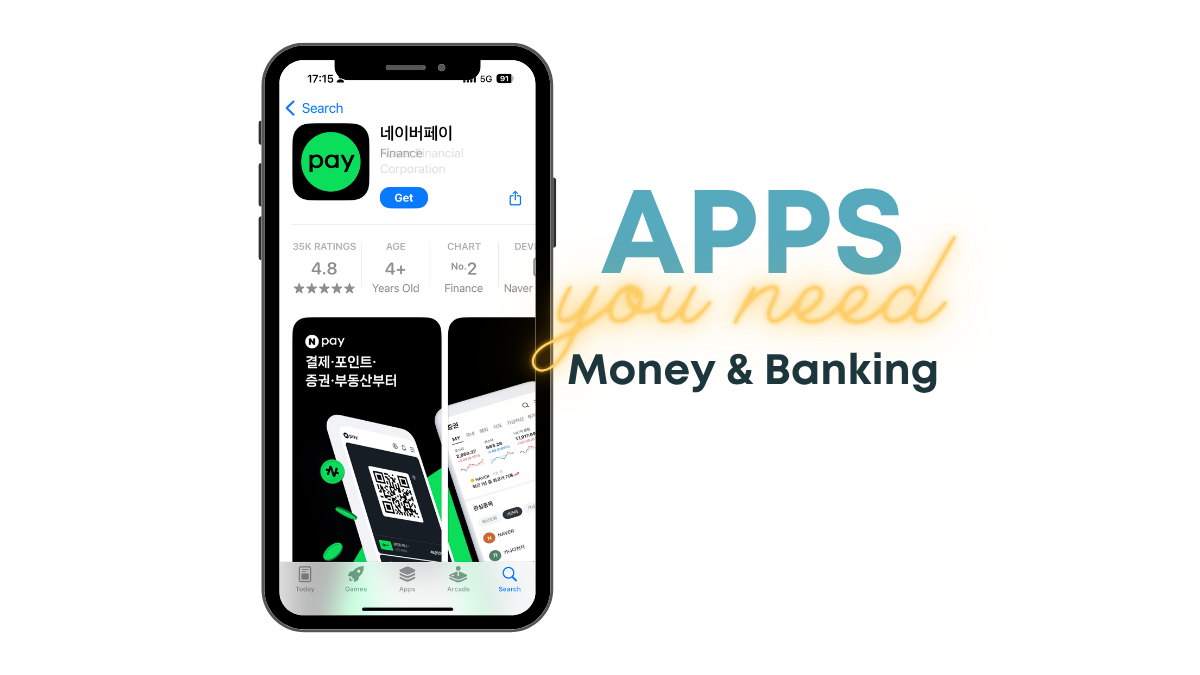
NaverPay
Hangul Name:
네이버페이
Description:
NaverPay (네이버페이) is a Korean digital payment system integrated into the Naver platform. It allows residents to make fast and secure payments for online shopping, food delivery, transportation, and even in-store purchases using QR codes or barcodes. Linked to Korean bank accounts or cards, NaverPay supports transactions on Naver services, Smart Store shops, and many Korean websites and apps. Unlike foreign payment options, NaverPay processes payments instantly and offers Korean-language customer service, exclusive coupons, and point rewards. It requires a Korean phone number and verified bank account for setup. For residents, adapting to NaverPay means smoother daily transactions and better access to local deals.
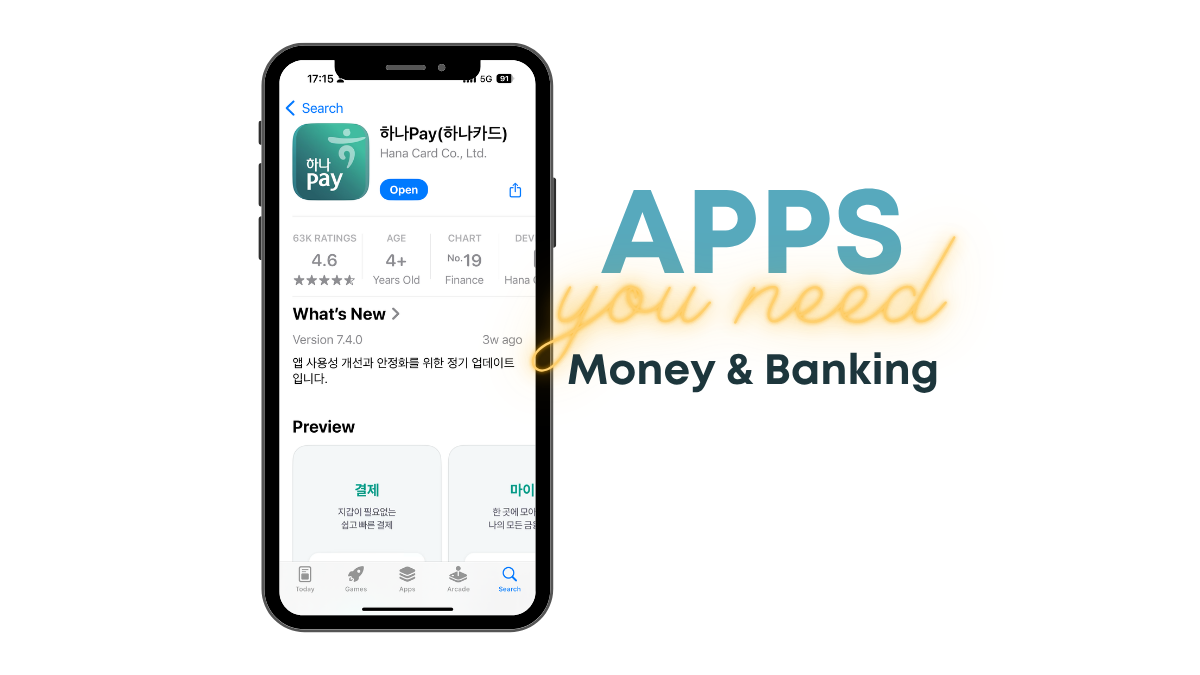
HanaPay
Hangul Name:
하나페이
Description:
HanaPay (하나페이) is a Korean digital payment service provided by Hana Financial Group. It allows users to make mobile payments, transfer money, and manage finances through the Hana Bank app or affiliated platforms. Linked directly to Hana Bank accounts or Hana credit/debit cards, HanaPay is primarily used by Korean residents who bank with Hana. It supports QR and barcode payments at participating merchants and offers integrated financial management tools. Unlike foreign payment apps, HanaPay is fully localized, provides Korean-language support, and connects seamlessly with Korea’s financial and ID verification systems. It requires a Korean phone number and Hana Bank account to register.
Recommended Transportation Related Apps
Getting around South Korea is efficient once you learn how to use the right apps. Local apps are deeply connected to Korea’s transportation systems, offering real-time updates, route planning, and mobile payments. International apps like Google Maps do not work well for public transit in Korea and may lead to confusion or missed connections.

TMoney
Hangul Name:
티머니
Description:
Tmoney (티머니) is a rechargeable transportation card and digital payment system used throughout South Korea. It allows residents to pay for subways, buses, taxis, and some convenience store purchases with a single tap. The physical card can be bought and recharged at convenience stores or subway stations, while the Tmoney mobile app supports digital payments via NFC-enabled Korean Android phones. Tmoney offers seamless travel without needing cash or tickets and is more reliable than foreign cards, which may not work with Korean transit systems. Residents benefit from fare transfers, discounts, and full integration with Korea’s public transportation network.

Kakao T
Hangul Name:
카카오 T
Description:
Kakao T (카카오 T), often called Kakao Taxi, is Korea’s most widely used taxi and mobility app. It allows residents to book regular taxis, premium taxis, pet-friendly taxis, and even designated driver services. The app supports real-time location tracking, estimated fare calculation, and mobile payment through KakaoPay or Korean credit cards. Kakao T offers more reliable service than foreign apps, which often don’t connect directly with local taxis. It is fully in Korean, though an English version is available with limited features. Residents benefit from faster pickups, driver reviews, and integration with Korea’s broader Kakao ecosystem.
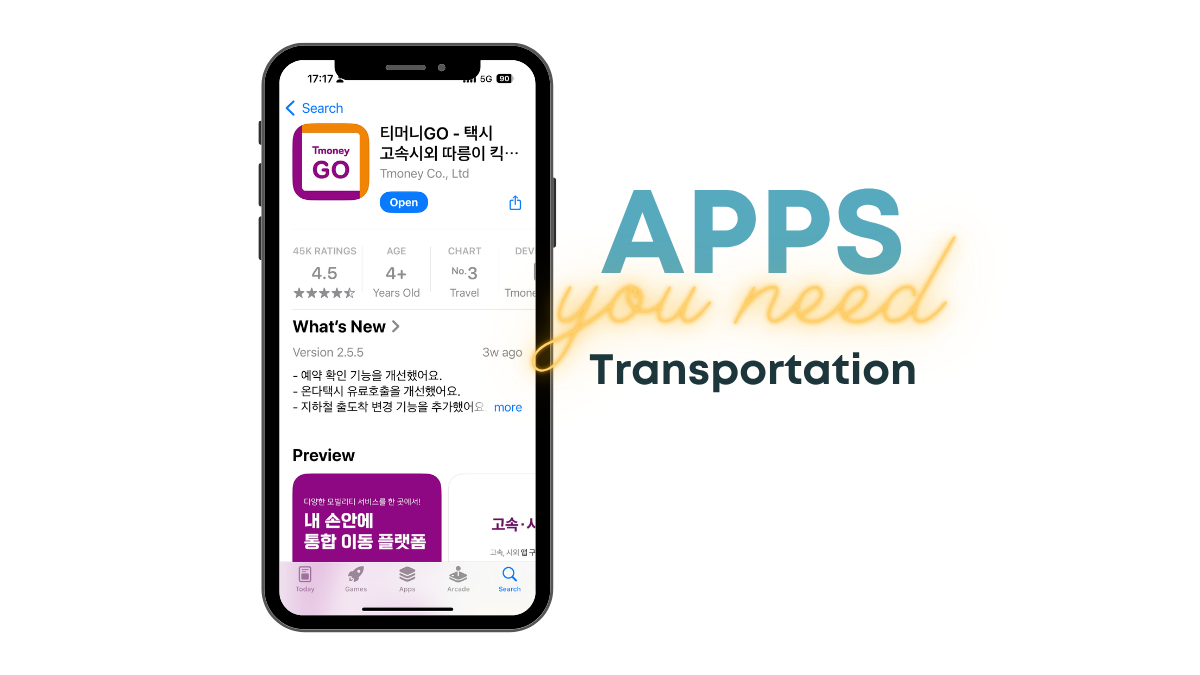
Tmoney GO
Hangul Name:
티머니GO
Description:
Tmoney GO (티머니GO) is a Korean mobility app developed by the creators of Tmoney. It integrates various transportation services—including buses, subways, taxis, e-scooters, and rental bikes—into one platform for real-time route planning, payments, and reservations. The app is designed for residents and requires a Korean phone number and local payment method such as Tmoney Pay or KakaoPay. Tmoney GO works better than foreign apps like Google Maps for navigation within Korea, offering more accurate routes, fare information, and integrated booking for public and private transport. Adapting to Tmoney GO improves daily commuting and helps residents navigate Korea’s transportation system efficiently.
Recommended Apps for Language Support

Papago Translation App
Description:
The best Korean translation app. You can even translate text from photos using your camera or a photo from your folders. There is also a website.

Google Translate App
Description:
Not as good as Papago for translating Korean, but still smart to have on hand.
Recommended Apps for Food Delivery
Some food delivery apps only work with Korean debit or credit cards. If you don’t have Korean banking, you may find Shuttle to be the very best option for you. It also has an easy English language interface.
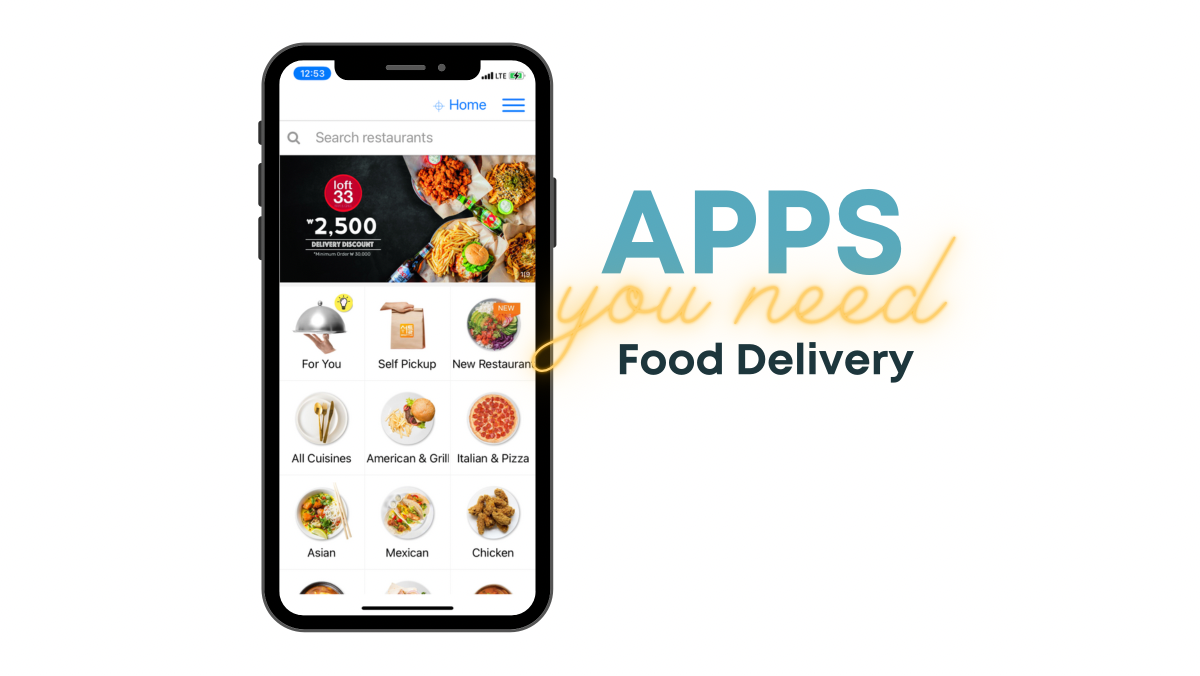
Shuttle Delivery
Description:
Shuttle Delivery provides delivery services from a variety of Korea’s best restaurants, so you can enjoy the best food in the comfort of your home, office, or wherever you happen to be! They offer a fully bilingual service where customers can place orders in either English or Korean. If you are not sure what to eat, you can check out the full range of options by selecting by cuisine! Click on the website link to get signed up! They have a website and a phone app. Use what’s comfortable for you. South of Seoul volunteers will get a discount and so will you when you place your first order.

Baemin Delivery App
Description:
Korean language delivery app that operates across Korea. You can download it to any phone by searching ‘Baemin’. Watch Google YouTube videos to learn how to navigate the app in Korean.

CoupangEats
Description:
CoupangEats is like the UberEats of Korea. They often have a wider delivery area than other apps. The app has an English interface.

Yogiyo Food Delivery App
Description:
Yogiyo is one of Koreans most established food delivery apps. The app is only in Korea but you can Google blogs and videos that will help you get registered. Remember, it will take some time to get it setup so don’t wait until you are hungry to start the process.
Recommended Apps for Navigation
South of Seoul, volunteers can not recommend using Google Maps or WAZE Maps (a Google-owned mapping company) for navigating Korea. Such apps do not have access to consistent, accurate information across South Korea. In areas with a great deal of development, the data in Google and WAZE can be completely inaccurate and off location by 2-3 km.
Additionally, Google Maps bus schedules are not current, and the times quoted for travel are not correct. Often incorrect by 2-4 hours. Yes, you can limp along using Google and WAZE, but it is nothing we can recommend.
Instead, we recommend taking the time to adapt to the following Korean mapping systems.

Naver Maps
Description:
Naver Maps is the top navigation app in South Korea and it has an English interface.

Kakao Maps
Description:
Kakao Maps is one of the leading map apps in South Korea.
Some Final Words
It’s tempting to stick with the familiar, but putting in a little effort to learn Korean apps will make a big difference in your daily life. You’ll be able to communicate more easily, get around more smoothly, and find everything from dinner to medical care without the stress of language or tech barriers.
If you spend just an hour a week getting used to apps like Naver Maps, KakaoTalk, or Coupang, you’ll be amazed at how quickly your life gets easier.
Take your time, be curious, and don’t be afraid to make mistakes. That’s how everyone starts—and before long, you’ll feel right at home.
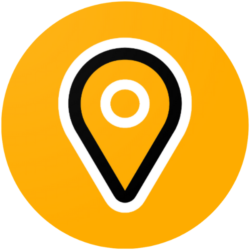
Founded in 2015, the South of Seoul team consists of volunteers on three continents working together to support English-speaking people traveling or living in South Korea. South of Seoul volunteers work with organizations and individuals across South Korea to improve equitable access to information across South Korea. Much of South of Seoul’s information focuses on Pyeongtaek, Gyeonggi-do, South Korea.
Blogs published under the authorship of “South of Seoul” include blogs compiled by multiple volunteers to improve access to standardized information unrelated to individualized personal experiences.



